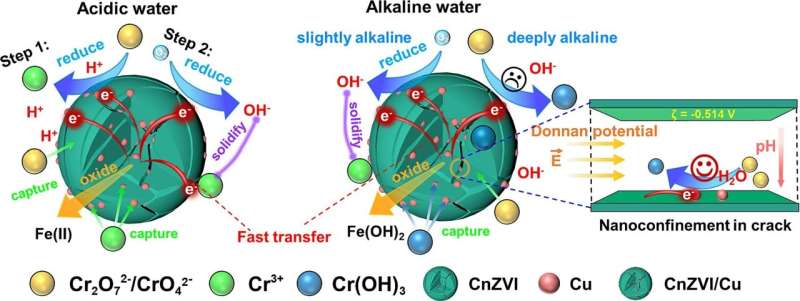This article has been reviewed according to Science X's editorial process and policies. Editors have highlighted the following attributes while ensuring the content's credibility:
fact-checked
peer-reviewed publication
trusted source
proofread
Novel nanocomposites proposed for highly efficient removal of hexavalent chromium in complex environments

Nano zero-valent iron (nZVI) is often used to remove chromium (VI), a heavy metal contaminant, because of its large specific surface area and high reducing activity. However, its effectiveness in removing trace heavy metals appears to be modest and sensitive to environmental pH.
A research team led by Prof. Wu Zhengyan and Zhang Jia from the Hefei Institutes of Physical Science of the Chinese Academy of Sciences recently offered their solution. In their study published in the Chemical Engineering Journal, they designed iron-based nanocomposite materials that combine galvanic reactions and nanoconfinement effects.
"This is an important progress," said Prof. Wu. "This material is good at getting rid of trace hexavalent chromium (Cr(VI)) from either acid or alkaline water, which could give us a new way to clean up heavy metal pollution under difficult conditions."
The magic nanomaterial they mentioned above is a Fe–Cu galvanic cell (CnZVI/Cu). It's composed of nZVI with nanocracks and Cu nanoclusters. By using the galvanic reaction to accelerate electron transfer and regulating the reaction environment by nanoconfinement effect, they can efficiently remove trace Cr(VI) in acid/alkaline water.
The researchers further analyzed the prepared CnZVI/Cu composites, and investigate their reduction rate and repair properties for trace Cr(VI) in different pH ranges. The mean pH value in the nanocracks and the spatial heterogeneity of the proton limit in alkaline solution were investigated based on theoretical calculations. It was demonstrated that the nanoconfinement effect can help the galvanic reactions to repair Cr(VI) efficiently under alkaline condition.
In addition, the secondary release of Cr and biosafety experiments show that CnZVI/Cu is both environmentally stable and biosafe.
This innovative nanomaterial shows great promise for the efficient removal of VI from wastewater with varying pH levels, indicating broad potential for practical applications in heavy metal pollution remediation, according to the researchers.
More information: Sijia Li et al, Integration of galvanic reactions and engineered nanoconfinement in iron-copper nanocomposites for highly-efficient remediation of Cr(VI)-contaminated acidic/alkaline water, Chemical Engineering Journal (2024). DOI: 10.1016/j.cej.2024.149533
Journal information: Chemical Engineering Journal
Provided by Chinese Academy of Sciences





















